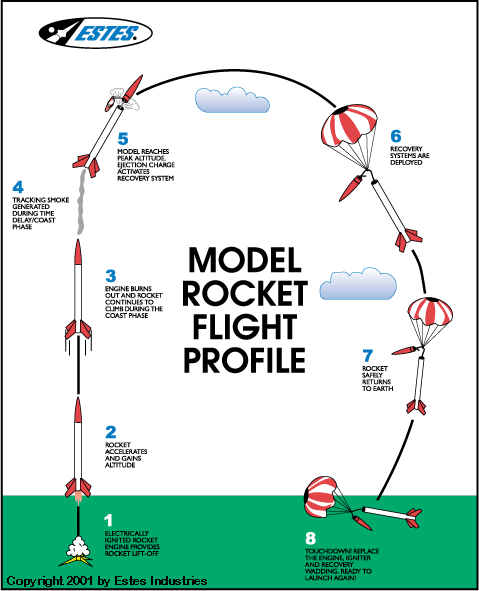Rocketry
Rocketry is a hobby that combines fun with learning, sport and real science. There is no special educational background necessary, and it is very simple to start with.
As Newton's Third Law defines, every action causes a reaction. Thus a rocket flies because the motor pushes hot gases and particles through the nozzle. The engines in rocketry are in most cases commercially manufactured engines like the ones from companies such as Estes, Aerotech or Sachsenfeuerwerk (Germany). The motors are rated in a certain way, usually it looks like this: A8-3, G64-4, H128-10, M1939. The numbers on the motor tells a rocketeer what kind of engine he has in his hands. An example: the label reads "A8-3". The letter defines the impulse, where "A" means 1,25-2,5 Ns (Newtonseconds). Each letter in the alphabet is the next higher impulse, so that "B" sums up engines from 2,5-5 Ns, "C" 5-10 Ns and so on. The largest commercially made motor is an "O" motor with 40.960 Ns impulse. The next number tells the average thrust in Newtons delivered by that engine, so "8" means the engines delivers 8 Newtons of thrust. As an aside: the engine has an impulse of 2,5 Ns and delivers a thrust of 8 N. If you divide those two, you come up with the burn time: 2,5Ns divided by 8N equals 0,33s, that is your burn time. The last number is the pyrotechnic delay in seconds that pushes out the parachute or some other recovery device.A rocket is reusable. It uses one or more parachutes to come back to Earth, those are being deployed by either pyrotechnic charges built in in the engine or by charges ignited by electronic devices such as altimeters, timers etc. The diagram below illustrates a rocket flight.

There are several types of rocketry that can be distinguished: